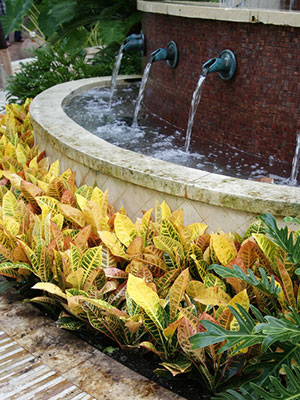Crotons
This plant will draw attention with its stunning color and make a bold statement in your house or yard.

Known for their bold, tropical foliage, crotons are perennial evergreen shrubs. Not only can these plants be grown outdoors in warmer parts of Florida, but some cultivars can be raised as decorative houseplants as well. The beautiful leaves of the croton are also used to enhance floral arrangements.
Characteristics
Grown for their fantastically marked leaves; crotons (Codiaeum variegatum) come in a wide variety of leaf shapes and colors which include reds, oranges, yellows, pinks, purple, greens, and white. Native to India and Malaysia, this tropical plant usually quite full and the leaves form clusters to create maximum color patterns. This shrub can grow up to 10 feet tall, but there are both dwarf and larger varieties. Crotons are easy to propagate, and are reasonably priced.
Many crotons grow best in full sun, but many cultivars can tolerate, and even prefer, light shade partial shade. Crotons are best grown in subtropical South and Central Florida. Frosts or freezes will damage them, but they quickly recover. When used outdoors this plant looks most attractive when grown in groups. Use them to accent green shrubbery and add a splash of color to any yard or container.
As houseplants, crotons add texture and color to dull interiors. When used indoors choose a cultivar such as the petra croton, that can remain brightly colored in indoor light conditions. Even these cultivars will eventually lose partial color if adequate light is not available. Keep children and pets from nibbling on crotons’ leaves, as they’re known to possess irritating and poisonous qualities. The sap from this plant is also known to stain.
Planting and Care
Croton shrubs can be purchased at most garden centers. If grown in containers, use a good quality potting media that provides adequate water drainage. When used in landscapes, plants should be located 2 to 3 feet apart. Crotons thrive in warm, humid weather and should be watered frequently, but not excessively. New foliage will wilt when thirsty, and can be used as a watering guide. Plants located indoors will become dusty in time and should occasionally be taken outside into a shady location to be washed off. This will also help manage spider mites which are occasional pests.
Again, bright sunlight will maximize croton colors, but overexposure can cause fading and restrict proper foliage growth. For outdoor crotons, full or shifting sun is ideal. Acclimated indoor plants respond well to partial sun and will still provide continuous color.
To propagate a croton plant, use a stem cutting that is 3-4 inches long and has 3 to 5 leaves. Dip the cut end of the cutting in an off-the-shelf rooting hormone and plant them in a small pot. Keep the soil moist, but not over watered. Cuttings will root in less than a month if temperatures stay between 70°-80°F. Transplant your new croton plant when a new roots system has have been established and there is noticeable new growth. New foliage will begin green and will develop color with maturity.
Crotons are usually pest and disease free, but can occasionally have mealybugs, scales, mites, thrip, and fungal problems. Keep a close eye on your plant and learn to recognize changes in leaf texture and insect residues.
For more information on crotons, contact your county Extension office.
